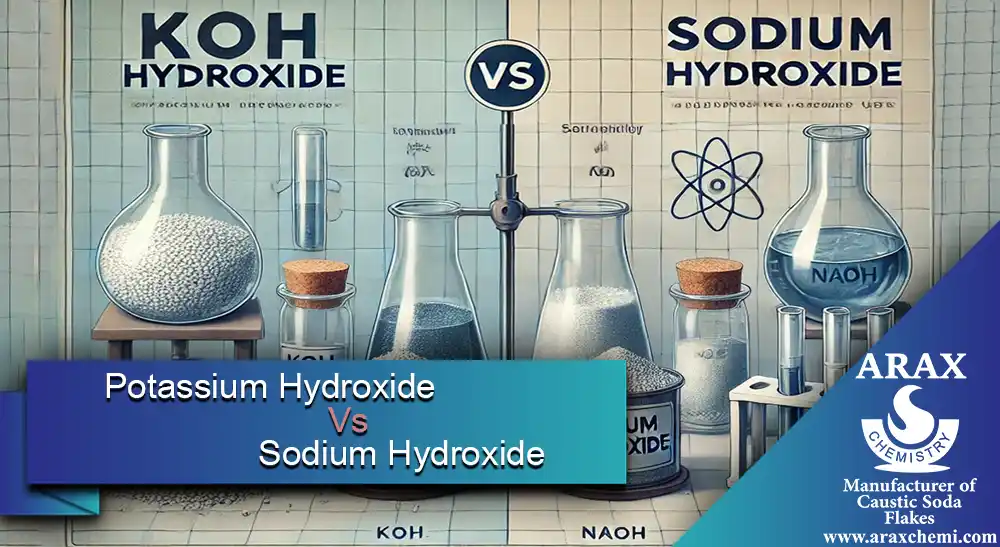Differences Between Potassium Hydroxide and Sodium Hydroxide A Comprehensive Guide
Sodium and potassium are highly reactive elements found in Group 1 of the periodic table, known as alkali metals. Both of these elements are classified as s-block elements due to their valence electron residing in the outermost s orbital. Sodium and potassium are incredibly valuable in the chemical industry as they form a wide range of compounds. Among these compounds, Potassium Hydroxide (KOH) and Sodium Hydroxide (NaOH) are two notable examples, both classified as alkali metal hydroxides. These compounds are ionic in nature, consisting of a metal cation and an –OH anion, and are known for being strong bases with highly corrosive properties. The primary difference between potassium hydroxide and sodium hydroxide lies in their chemical composition—Potassium Hydroxide contains a potassium cation (K⁺), while Sodium Hydroxide contains a sodium cation (Na⁺).
What is Potassium Hydroxide?
Potassium hydroxide (KOH), commonly referred to as caustic potash, is a strong alkali widely used in industrial and laboratory applications. At room temperature, it is a colorless, odorless, deliquescent solid, meaning it readily absorbs water vapor from the air to form an aqueous solution. Its molar mass is 56.11 g/mol, and it has a melting point of 360°C and a boiling point of 1,327°C.
Key Applications of Potassium Hydroxide:
- Cleaning Products: Commonly found in soaps and shampoos.
- pH Regulator: Due to its strong alkalinity, it is often used to control acidity levels.
- Medical Use: Utilized in diagnosing fungal diseases
- Batteries: A component in alkaline batteries
- Food Industry: Used as a stabilizer in food additives.
What is Sodium Hydroxide?
Sodium hydroxide (NaOH), also known as caustic soda, is another highly reactive alkali metal hydroxide. It appears as a white, waxy solid at room temperature and is odorless. Its molar mass is 39.99 g/mol, with a melting point of 318°C and a boiling point of 1,388°C. Sodium hydroxide is highly soluble in water, and its dissolution in water is an exothermic process, meaning it releases heat.
Key Applications of Sodium Hydroxide:
- Cleaning and Disinfectant Products: Used in the manufacturing of soaps and detergents.
- Pharmaceuticals: Plays a role in the production of medicines like aspirin.
- Water Treatment: Helps control water acidity.
- Wood and Paper Industries: Used to dissolve unwanted materials in wood processing.
- Food Industry: Helps in peeling tomatoes and other produce.
Similarities Between Potassium Hydroxide and Sodium Hydroxide
Both potassium hydroxide and sodium hydroxide share several common properties:
- Alkali Metal Hydroxides: Both are strong bases and highly reactive.
- Water Solubility: Both compounds dissolve readily in water.
- Highly Exothermic Reactions: Their dissolution in water releases significant heat.
- Corrosive Nature: They can cause skin irritation and burns upon contact.
- Hygroscopic Properties: Both can absorb water vapor from the air.
Key Differences Between Potassium Hydroxide and Sodium Hydroxide
Although these two compounds are similar, they exhibit important differences:
- Molecular Composition:
- Potassium Hydroxide (KOH): Composed of potassium cations and hydroxide anions. Its molar mass is 56.11 g/mol.
- Sodium Hydroxide (NaOH): Composed of sodium cations and hydroxide anions. Its molar mass is 39.99 g/mol.
- Solubility:
- Potassium Hydroxide: Less soluble in water than sodium hydroxide.
- Sodium Hydroxide: Highly soluble in water and absorbs moisture from the atmosphere.
- Reactivity with Water:
- Both compounds react exothermically with water, but sodium hydroxide tends to release more heat compared to potassium hydroxide.
- Industrial Production and Cost:
- Sodium Hydroxide: Manufactured from sodium chloride (table salt), making it more cost-effective.
- Potassium Hydroxide: Derived from potassium chloride, which is more expensive, leading to a higher market price.
- Melting and Boiling Points:
- Potassium Hydroxide: Melting point of 360°C and boiling point of 1,327°C.
- Sodium Hydroxide: Melting point of 318°C and boiling point of 1,388°C.
Conclusion
Both potassium hydroxide and sodium hydroxide are vital compounds in various industries, ranging from cleaning products to food processing and pharmaceuticals. While they share many properties as alkali metal hydroxides, their molecular differences, solubility, and reactivity lead to distinct applications and varying production costs. Potassium hydroxide is often preferred for specialized applications like high-performance soaps, while sodium hydroxide is a more economical choice for broader industrial uses. For high-quality chemical product, including Caustic Soda Flakes, steel, PP fabric ARAX CHEMISTRY is a trusted manufacturer, providing top-tier materials for a variety of industries.
FAQs Potassium Hydroxide vs Sodium Hydroxide
- What are the main differences between Potassium Hydroxide and Sodium Hydroxide?
Potassium Hydroxide (KOH) and Sodium Hydroxide (NaOH) are both alkali metal hydroxides, but they differ in composition. Potassium Hydroxide contains potassium ions (K⁺), while Sodium Hydroxide contains sodium ions (Na⁺). Additionally, KOH has a higher molar mass (56.11 g/mol) compared to NaOH (39.99 g/mol), and their solubility and heat release in water also vary. - What are the key applications of Potassium Hydroxide?
Potassium Hydroxide is widely used in: 1.Cleaning products like soaps and shampoos 2.pH regulation due to its strong alkalinity 3.Medical diagnostics for fungal infections 4.Alkaline batteries 5.As a stabilizer in the food industry. - What are the main uses of Sodium Hydroxide?
Sodium Hydroxide is commonly used in: 1.The production of soaps and detergents 2.Pharmaceuticals like aspirin 3.Water treatment to regulate acidity

You Are The Best at What You Do!
The Best!